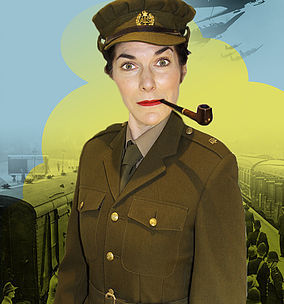Beyond the Home Front

Kate Cook in The Invisible Woman
By JULIE ANDERSON
Elsie Cawser���s comic poem from the Second World War, Salvage Song (or the Housewife���s Dream) ends with the lines, "So now when I hear on the wireless, / Of Hurricanes showing their mettle, / I see in a vision before me, / A Dornier chased by my kettle". The drive for metals to make weapons such as Spitfires required many women to give up useful household items. Cawser���s poem epitomizes the struggles of women on the home front to juggle their domestic needs with the rapacious requirements of a nation at war. The majority of histories written about war tended to focus on women keeping the home fires burning. Many of the preconceptions surrounding women in war have cast them as keepers of the home or carers; roles that demonstrate women���s support of the quintessentially male practice of war.
Britain is currently in the grips of remembering and commemorating the First World War, which was fought and documented by men. Women���s wartime experience during 1914���18 was centred around nursing, epitomized by Vera Brittain���s book, Testament of Youth. The Second World War placed women in the conflict, as the fluid fighting lines and bombing of civilian targets, meant that in some cases, the war came right through their front doors, with devastating effects. Yet women maintained their supporting role, dealing with the impact of war and its aftermath, which included suicide, disability and domestic violence. There were many ways a woman could lose a husband, father or son to war. It became clear to those interested in the subject of women and war that women���s role in war was more complex and less constrained by domesticity than previously thought. War correspondents such as Lee Miller, Martha Gellhorn and later Kate Adie normalised the public presence of women in conflict zones. Female world leaders were unafraid to take centre stage in supporting conflict. In 1986, the world witnessed the incongruous, yet in the light of her role in the Falklands War, unsurprising, image of Prime Minister Margaret Thatcher, at a NATO camp in Germany clad in a cream coat, headscarf, gloves, and goggles, riding in a Challenger tank. The reaction to a female world leader in close proximity to weapons of war caused one Daily Telegraph reporter to note that she looked like "a cross between Isadora Duncan and Lawrence of Arabia".
Today, women can take up official combatant roles in a number of countries��� armed forces. So the Women and War Festival, a month-long exhibition (ends July 31) presented by the So and So Arts Club in the City of London, reflects this change from supporter to participant. In this festival of drama, music and dance, accompanied by film screenings and talks, women are soldiers, spies, refugees, veterans and victims. They are also mothers, wives, children, nurses, prostitutes and entertainers. This festival explores universal women���s war experiences, yet still retains the profoundly personal experience of an individual caught up in conflict.
As soon as you go into Fredericks Place, you are transported by the arresting and disturbing images of war by photographers Keymea Yazdanian and Alison Baskerville, and the war paintings of Arabella Dorman which occupy the walls of some of the rooms. Many of Dorman���s images of Afghanistan feature groups of girls, a reminder of the danger that growing up in a conflict zone presents to girls threatened by sexual assault, trauma and disruption to their schooling.
Many of the performances on offer are inspired by historical events, which reflects an awareness of the number of roles that women have played in conflict. During the Festival, I learned that Aphra Behn, the seventeenth-century female playwright, also had a career as a spy during the Dutch Wars. In Invisible Woman ��� one of many one-woman shows at the Festival ��� about a female spy during the Second World War, far removed from the worries associated with the loss of one���s saucepans, a woman named Mrs Bishop is sent to France to assist the French Resistance. The actress Kate Cook tells the audience how she used the Mass Observation Archive to research the many roles she takes on during her performance. Cook, demonstrating an extraordinarily wide range, plays at least a dozen characters, from the jolly-hockey-sticks spy Florence to Mrs Bishop���s husband, a wounded war veteran.
The Festival gives a sense of the variety of women���s experiences of war, cutting across class, age, religion, race, and history. No woman���s experience of conflict is the same, yet the unique experience of individual women speaks to a collective understanding of the effect of conflict on women���s lives.
Peter Stothard's Blog
- Peter Stothard's profile
- 30 followers



